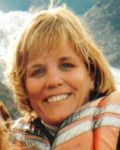Ph.D. in Education, 2013
School of Education
October 1, 2008
Making Science Visible: Ph.D. Student Janice Hansen Explores the Use of Visual Representations In 8th Grade Science Classrooms
Imagine you are a middle school science teacher preparing a lesson about the solar system. How would you teach your students about the paths the planets take as they orbit the Earth? One thing you could not do is take your class on a field trip to experience orbit firsthand. In fact, many scientific phenomena students learn about are either far too large or much, much too small to be observed directly in a typical class lesson. So, teachers get creative and visual aids to represent many concepts.
Second year Ph.D. student Janice Hansen is interested in the use of visual representations in science classrooms. Photos, diagrams, charts, animated videos and other visual aids can be very useful in helping students to develop understanding, yet they also have the potential to contribute to the development of misconceptions. In order to understand the most effective types of visual aids and methods of presenting them in instruction, Janice’s research focuses on isolating and investigating the use of these tools in typical science classroom settings.
Janice is working with Dr. Lindsay Richland to examine video data collected as part of the Trends in International Math and Science Study (TIMSS). Currently, Janice is examining eighth grade science lessons taught in the United States. She is collecting data on the types of visual aids used and the ways in which they are employed in instruction. The goal is to determine whether there are differences in the way visual aids are used in lessons that focus on building connections between concepts versus those that are not focused on connection-building. Eventually, the project will grow to include cross-national comparisons of the use of visual representations. Janice hopes this work will one day inform the development of more effective visual aids and practices for utilizing them in science classrooms.
Prior to entering the inaugural Ph.D. in Education cohort at UCI, Janice earned a Bachelor of Social Work degree at Arizona State University where she was honored as the Outstanding Student of her graduating class and asked to give the commencement address. She worked with troubled teens for a number of years where she saw firsthand the role education can play in changing lives. She entered graduate school at California State University, Long Beach, and earned a Master’s of Arts in Education-Educational Psychology. She taught Educational Psychology classes at CSULB for five years while waiting for the long-anticipated doctoral program at UCI to be unveiled.
Janice enjoys writing and making research readable. She is the co-author of a chapter on accountability in K-18 school partnerships in the book, “Accountability for Performance: Pre-Kindergarten through Graduate School,” which was published in 2004 (K.C. Cohn and C. A. Cohn, editors). At UCI, she has been privileged to expand her understanding of the use of experimental research in education in her work as a graduate student researcher for Professor Michael Martinez. The pair have collaborated on two successful conferences for Math and Science Partnership (MSP) researchers and National Science Foundation personnel. The conferences included presentations by such noteworthy scholars as Adam Gamoran, William Shadish and Robert Boruch. Dr. Martinez and Janice are currently working on developing a third conference on the role of experimentation in educational research.
Janice is honored to be a part of the amazing first cohort of Ph.D. students in the UCI Department of Education and finds the atmosphere to be both supportive and challenging. She is looking forward to the new academic year, meeting the incoming faculty and students, and reconnecting with her cohort.
